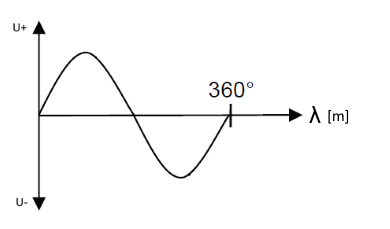Frequency and Wavelengths
Calculator and formulas for calculating frequency and wavelength
Frequency / Wavelength Calculator
Frequency-Wavelength Calculator
On this page you can calculate the wavelength for a given frequency, or the frequency for a given wavelength. Wavelengths for electrical oscillations, light, and sound can be calculated.
|
|
Frequency & Wavelength

Wavelength λ of a periodic oscillation
Parameters
Basic formulas
Tip
A calculator for calculating frequency and period can be found here.
|
|
Propagation speeds
Speeds of different types of waves
The wavelength depends on the frequency and the propagation speed of the waves. The following table shows the propagation speed of different waves in various media.
Electromagnetic waves
299,792,458 km/s≈ 240,000 km/s≈ 200,000 km/s299,792,458 km/sMechanical waves
343 m/s1,470 m/s≈ 5,000 m/s1-14 km/sExample calculations
Practical calculation examples
Example 1: Calculating frequency
Given: λ = 10m, c = 300 m/s (example sound speed)
Example 2: Calculating wavelength
Given: f = 50Hz, c = 340 m/s (sound speed in air)
Example 3: Electromagnetic wave
Given: f = 100MHz (FM radio), c = 3×10⁸ m/s
Wavelength spectrum
Radio waves:
Microwaves:
Light:
Formulas for Frequency and Wavelength
Basics of wave propagation
The wavelength refers to the length of one period of a propagating oscillation. It depends on the frequency and the propagation speed of the waves.
Basic relationships
The wavelength λ in meters is calculated by dividing the propagation speed c by the frequency f.
Wavelength formula
The wavelength is proportional to the speed and inversely proportional to the frequency.
This results in the following formula for calculating the frequency:
Frequency formula
The frequency is proportional to the speed and inversely proportional to the wavelength.
Different types of waves
Electromagnetic waves
- Propagation: In vacuum at the speed of light
- Medium: Do not require a transmission medium
- Speed: c = 299,792,458 m/s
- Spectrum: Radio to gamma radiation
Mechanical waves
- Propagation: Require a medium
- Medium: Air, water, solids
- Speed: Depends on material
- Examples: Sound, seismics, water waves
Practical applications
Radio technology
- Antenna design
- Frequency bands
- Propagation models
- Interference analysis
Optics
- Color spectrum
- Diffraction grating
- Laser technology
- Spectroscopy
Acoustics
- Room acoustics
- Ultrasound
- Musical instruments
- Noise protection
Legend
Symbol definitions
Design notes
Practical considerations
- Antenna design: Optimum length at λ/4, λ/2 or multiples
- Wave propagation: Obstacles can cause diffraction at λ size
- Interference: Constructive/destructive superposition at λ/2 distances
- Resonance: Cavity resonators at λ/2 dimensions
- Dispersion: Speed can be frequency dependent
- Attenuation: Losses often depend on frequency and medium
|
|